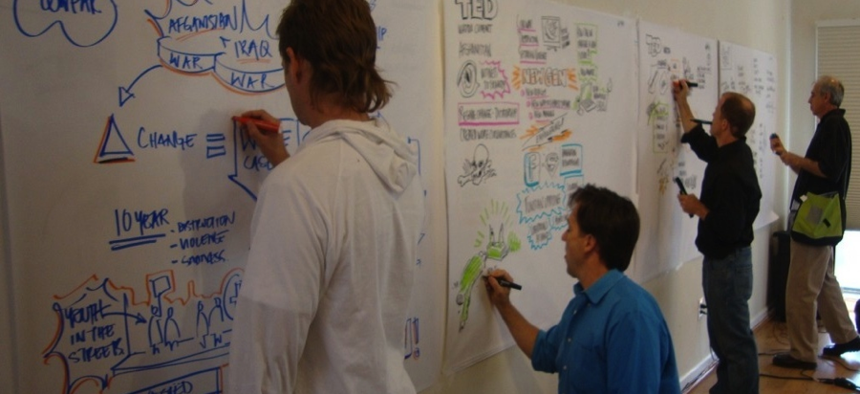
By helping teams draw out big ideas Maga Design is turning organizational vision into reality.
Get Visual: Why Your Team Should Start Drawing
How cutting edge teams are using map making to spur innovation.
Ever since I can remember I have loved the world of comic books, action figures, super heroes and their superpowers. I think map-making is one of the most important superpowers to have in today’s complex world. Complexity threatens to overwhelm and crowd out clarity in every organization I know. At Maga Design we’ve been making maps for the past decade to help people in organizations see and define their futures. Like my favorite super hero, Wolverine, maps have the powerful ability to heal any organizational toxin. Here’s why: to make a map for an organization work it needs to be made collectively – with the leadership, the stakeholder, and the organization’s customers. For starters, that means people get on the same page, literally.
We call visual information mapping a “lite” methodology because it records what is and what is to be, visually, in a picture, at a glance, allowing any audience to overcome "Death by PowerPoint" with a single jump, or in this case a single page. What busy person doesn’t want that? We have found that single page maps of complex scenarios like installing a new IT platform, or launching a new product, or explaining how missions get formed at National Geographic can be very useful learning tools and a lot of fun for those involved in its creation.
Maps Are Us
When you think about it, maps are lodged in our DNA–lost or found we turn to them when we want to figure out the way forward. Neuroscientists tell us that our brains have the innate capacity to quickly recognize and comprehend shapes. Whether it’s rivers, highways and points of interest –or visions, strategies and key references–our maps help innovators share big messages consistently by using visuals in compelling ways to connect with diverse audiences.
What We’ve Learned by Making Maps
By making hundreds of maps, our firm, Maga Design, has evolved into what I see as a visual systems integrator of others’ strategies, innovation pipelines, communications campaigns and IT architectures. Here’s what we’ve learned in the process that we think may be helpful to you on your innovation journey.
- Maps are tactile
- Maps are persistent
- Maps lead to outcomes
More importantly, we see the level of stress, anxiety and fear decrease, replaced instead by alignment, excitement and a sense of “we're in it together and here’s where we’re going.” That is of course, what a map is for. Most of the client environments we work in deal with high levels of concern, or even risk. Change stresses people out. People always want to know the "why, what and how" of change and, ultimately, how it will affect them. Maps serve two powerful functions here: they acknowledge the human need for context, to see the big picture, and they help explain what’s new and what’s next.
The kinds of bets innovators have to place on the future are particularly stressful.
The visual collaboration mapmaking requires (i.e. making pictures about the world together) reduces stress, releases creative energy and…serves as a de-conflictor.

Mapping conversations is the first step to creating a Maga Map – some are linear, some aren’t. But by getting them on paper we always provide a way to envision what’s next.
One of the by-products of our work with teams over the years is discovering that the process is as important as the product. We’ve seen team after team step up to embrace the noble challenge of mapping their own destiny when we get in a room and begin to draw what’s next together. We call those graphically facilitated sessions and they are the best way we know to begin any project.
As Map Making Explores and Reduces Complexity, it Creates Visual Clarity
In trying to explain itself to itself and its customers, every organization we know has PowerPoint fatigue and not too many easy alternatives. Our maps tell stories, and stories help people understand, remember and take action. Because there’s only so much information you can put on one page, finding metaphors that fit and contain your core message is a superpower. Deciding how to use the remaining real estate, analyzing the key messages and their hierarchies is an important next step. The end product is a visual map that makes it easier.

How do you describe a new software offering to the world? Here’s how we helped Vivisimo do it in one page.
Today, every company lives and dies on the strength of their ideas. What we’ve seen is that these one page communications spur new interactions because they are the equivalent of internal cause marketing, thereby makes ideas visible for the organization. When we do this for our clients we feel a little bit like a VCR or media player for a client’s thought leadership or most closely held vision. We help them bring it to life.
I keep our Maga strategy map in front of me daily. Every single one of our employees has it too. It helped set the table and set the frame of mind for our company. It was our thought leadership and our vision and we took the time to put it down on paper.

Maga’s 2011 Strategy Placemat Map
When we work, wherever we work, people pull us aside to tell us that “they really are visual learners.” Of course they’re right, they, and all of us ARE visual! It’s our birthright as human beings to want to draw, to want to collaborate, to want to see our futures. What I like most about maps is the adventure of making them.
(Images via magadesign.com)







